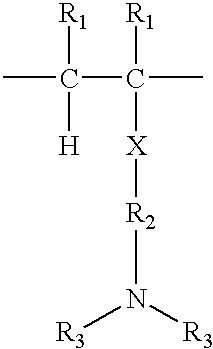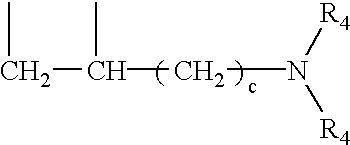Method for manufacturing laundry additive article
- Summary
- Abstract
- Description
- Claims
- Application Information
AI Technical Summary
Benefits of technology
Problems solved by technology
Method used
Image
Examples
example 1
[0128] A combination of water soluble chemicals were mixed together in a 15 gallon tank based on the composition tabulated below. A stream "A" from this tank having a concentration of about 30% was pumped at a rate of about 5.6 kg / hr through slot die coater # 1 and delivered a coating onto a 120 gsm, 50 cm wide non-woven web moving at 1.5 m / min. Next, a stream "B" of Kymene was fed from another tank at a rate of 4.2 kg / hr through a second slot die coater #2 onto the same side of the web over the first layer delivered by slot coater #1. The continuously moving web then entered a forced air convection oven operating at 150C. The moisture content of the web exiting the oven was below 10%. The total amount of wet coating delivered to the web was about 255 gsm and total amount of solids deposited on the web after drying was about 58 gsm.
2TABLE 1 g / m.sup.2 Dry g / m.sup.2 Wet Stream % Active Basis Basis B Slot Coater #2 Kymene 12.5 13.57 108.60 A Slot Coater #1 PVPVI 30 40.72 135.75 PVNO 40...
example 2
[0129] A combination of water soluble chemicals were mixed together in a 50 gallon tank based on the composition tabulated below. A stream "A" from this tank having a concentration of about 32% was pumped at a rate of 63.9 kg / hr through slot die coater # 1 and delivered a coating onto a 120 gsm, 50 cm wide non-woven web moving at 15 m / min. Next, a stream "B" of Kymene was fed from another tank at a rate of 42.0 kg / hr through a second slot die coater #2 onto the same side of the web over the first layer delivered by slot coater #1. The continuously moving web then entered a forced air convection oven operating at 150C. The moisture content of the web exiting the oven was below 10%. The total amount of wet coating delivered to the web was about 273 gsm and total amount of solids deposited on the web after drying was about 67 gsm.
3TABLE 2 g / m.sup.2 Dry g / m.sup.2 Wet Stream % Active Basis Basis B Slot Coater #2 Kymene 12.5 13.57 108.60 A Slot Coater #1 PVPVI 30 40.72 135.75 PVNO 40 4.52...
example 3
[0130] A combination of water soluble chemicals were mixed together in a heated 50 gallon tank to about 60-70C based on the composition tabulated below. A stream "A" from this tank having a concentration of about 47.5% and containing a surfactant was foamed at a rate of 47.9 kg / hr onto the top side of a 50 cm wide, 120 gsm non-woven web moving at 15 m / min using foaming equipment known in the art for coating webs and supplied by Gaston County, N.C., USA. The surfactant known as Amphosol CA was supplied by Stepan, Ill., USA. Next, a stream "B" of Kymene was fed from another tank at a rate of 13.1 kg / hr Kymene was sprayed onto the same top side of the web sing fine spraying nozzles supplied by Spraying Systems Inc, Ill., USA. The continuously moving web then entered a forced air convection oven operating at 150C. The moisture content of the web exiting the oven was less than 10%. The total amount of wet coating delivered to the web was about 157 gsm and total amount of solids deposited...
PUM
| Property | Measurement | Unit |
|---|---|---|
| Fraction | aaaaa | aaaaa |
| Fraction | aaaaa | aaaaa |
| Fraction | aaaaa | aaaaa |
Abstract
Description
Claims
Application Information
 Login to View More
Login to View More - R&D
- Intellectual Property
- Life Sciences
- Materials
- Tech Scout
- Unparalleled Data Quality
- Higher Quality Content
- 60% Fewer Hallucinations
Browse by: Latest US Patents, China's latest patents, Technical Efficacy Thesaurus, Application Domain, Technology Topic, Popular Technical Reports.
© 2025 PatSnap. All rights reserved.Legal|Privacy policy|Modern Slavery Act Transparency Statement|Sitemap|About US| Contact US: help@patsnap.com



